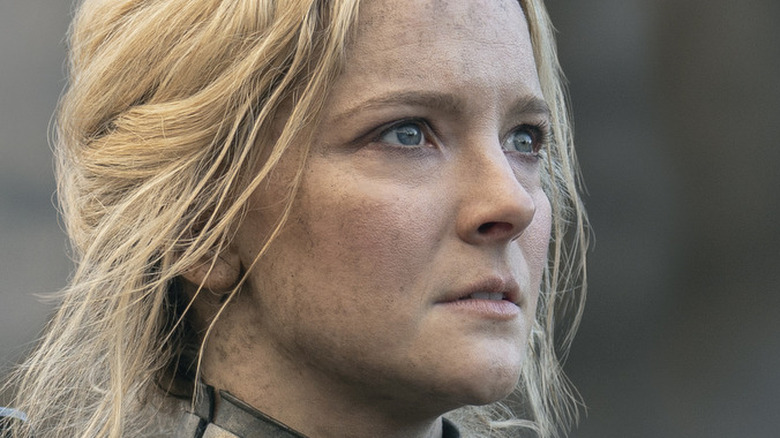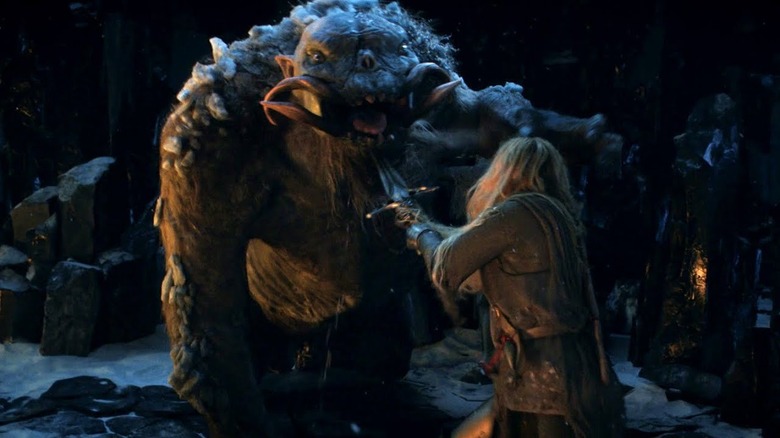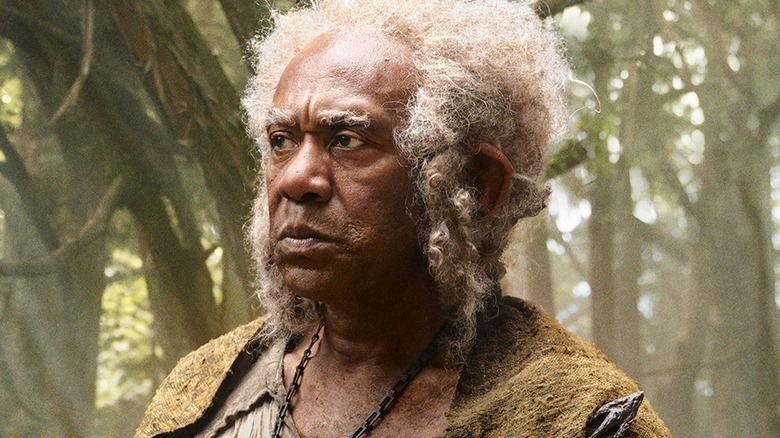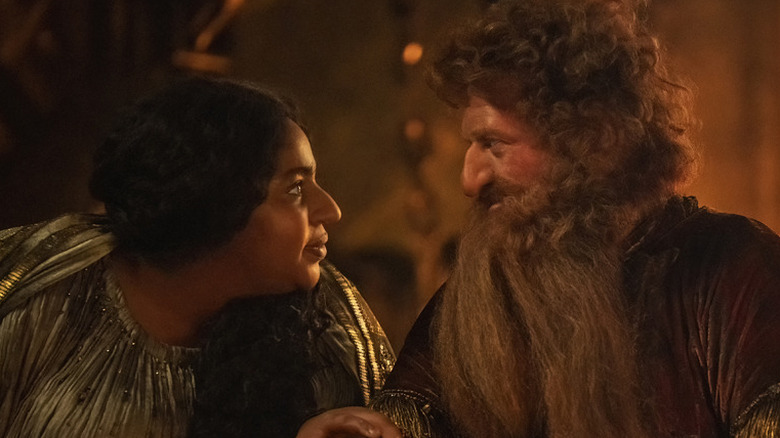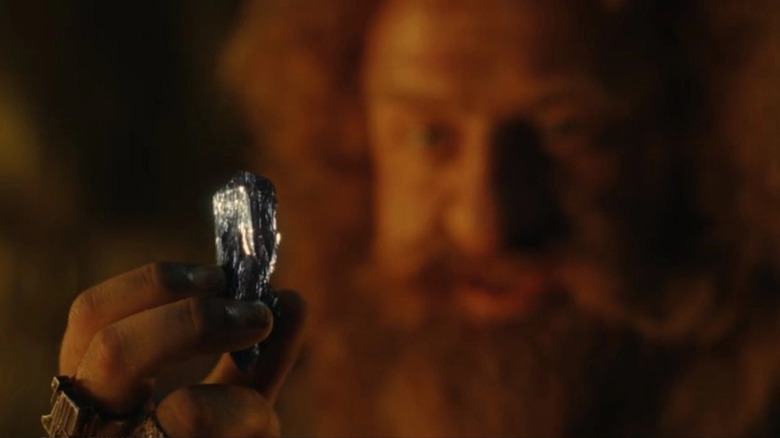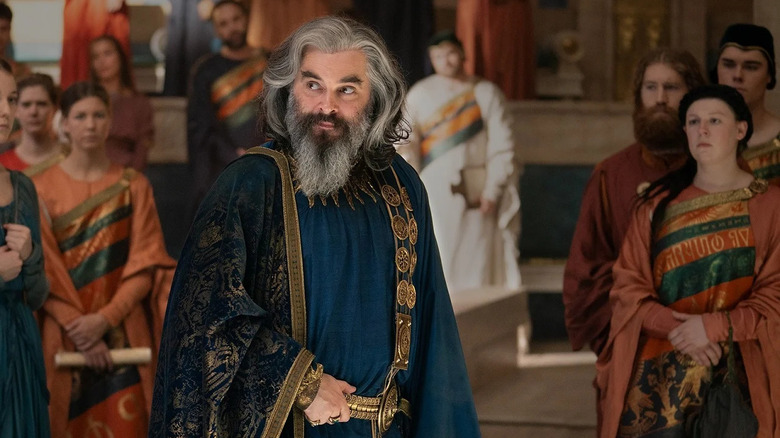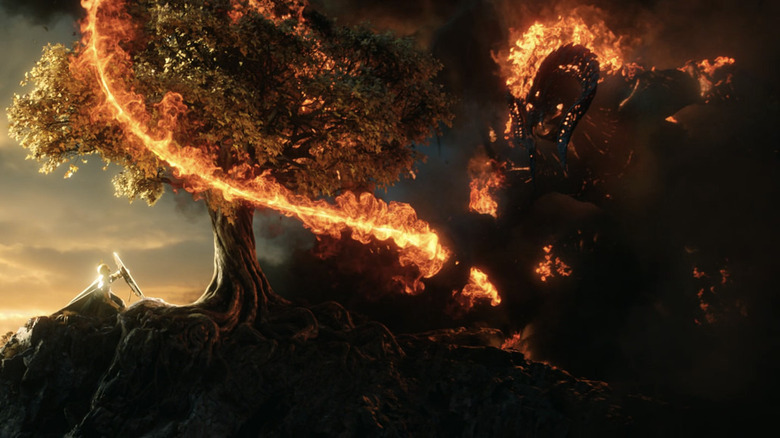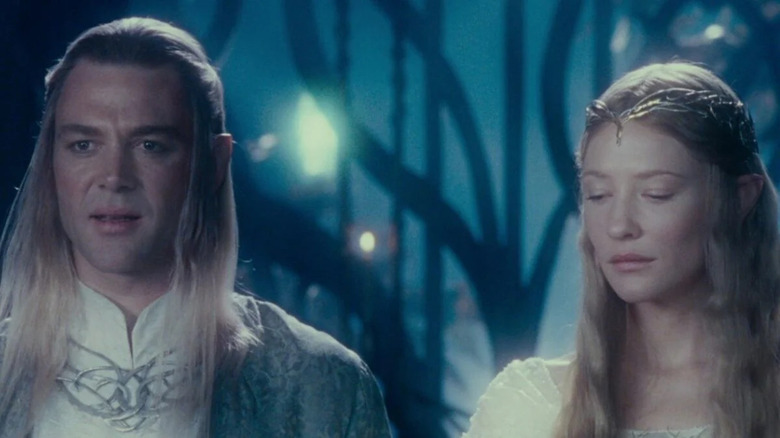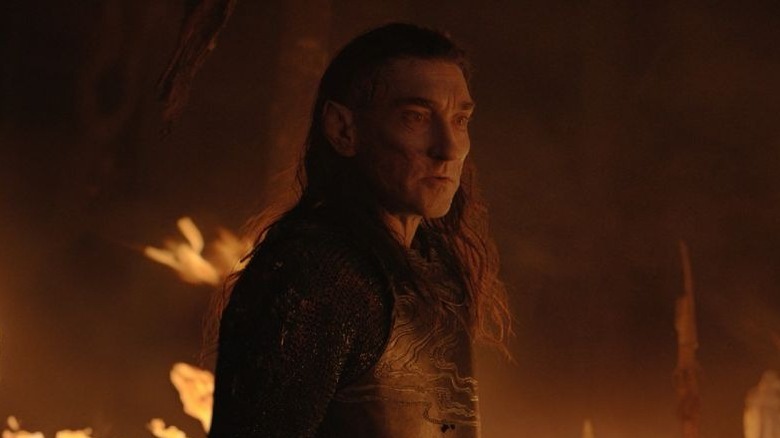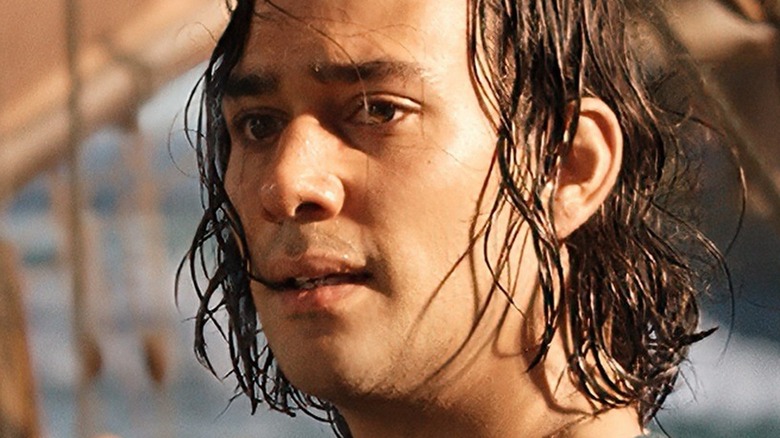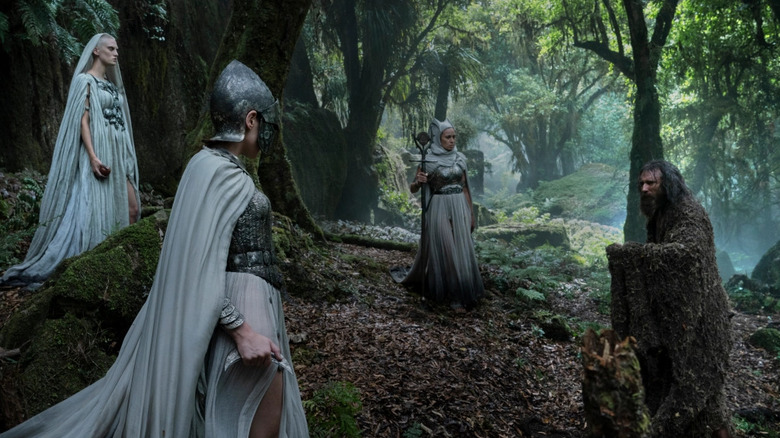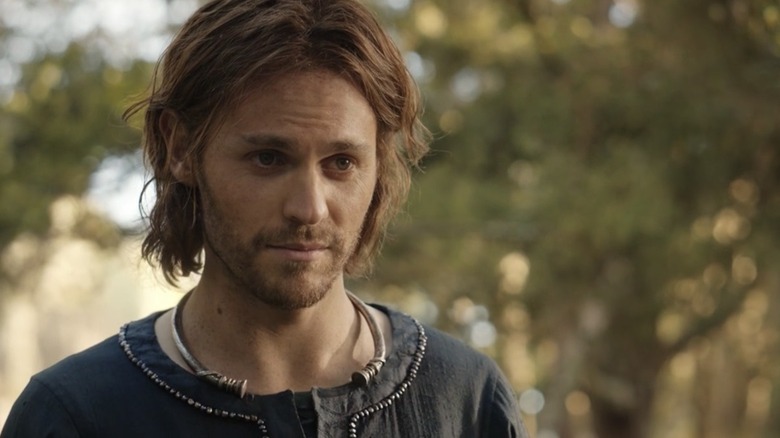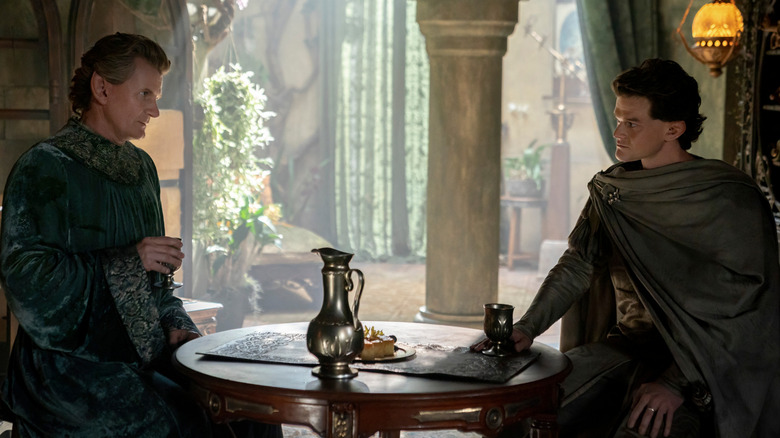The Lord Of The Rings: The Rings Of Power Moments That Really Upset Fans The Most
Announced as part one of five planned seasons, the first season of Amazon's "The Lord of the Rings: The Rings of Power" came with loads of controversy. From the deluge of racist reactions to the casting of people of color in major roles to Tolkien fans nitpicking the lore, nearly every week brought something else to a head. After eight 70-minute episodes, the first season of "The Rings of Power" came to an eventful conclusion.
Set centuries before the events of the Peter Jackson "Lord of the Rings" movies, "The Rings of Power" tells the story of the forging of the One Ring and how Mordor came to be. The events of the show center around old favorites like the Elves Galadriel (Morfydd Clark) and Elrond (Robert Aramayo) and new characters created for the show like the half-Orc leader Adar (Joseph Mawle). As the series' first season unfolds, these parallel journeys converge into one tale of rising darkness and dying light that connects (almost) all of its threads in the end.
Sadly, in an effort to control the discourse surrounding "The Rings of Power," the aforementioned chud mob embarked upon a rigorous review bombing campaign against the show, rendering Rotten Tomatoes and similar sites functionally useless for gauging the genuine public consensus regarding its merits. We know a ton of people watched it, but ratings are never the be-all and end-all of any show's success.
Is "The Rings of Power" great, as some folks say? Is it the worst TV show ever made, as is declared by some people who sound like they're arguing in bad faith and don't understand that talking exclusively in hyperbole makes them look bonkers? Is it a perfectly fine fantasy-action series and everyone needs to calm down? You be the judge. Of course, for all its high points, "The Rings of Power" couldn't help but frustrate Tolkien diehards. After all, part of the fun of being a nerd is complaining about pedantic details in sci-fi-fantasy media. These are the moments that upset fans the most across all eight of the season's episodes.
The snow troll fight
One of the first "Rings of Power" moments that directly brought to mind a scene from the Peter Jackson films was the snow troll fight scene in the show's first episode. Here, Galadriel encounters a troll in her search for the shadow of Sauron. The fight with a troll in Moria in "Fellowship of the Ring" is the first moment we get to see the band of warriors show their talents in battle. But this scene also works to show just how treacherous a mere troll can be and how much challenge lies down the road ahead. Some viewers took issue with this fight scene in "The Rings of Power" because Galadriel walks all over her prey.
A few fans on Reddit criticized the sequence and called out its choreography as being ridiculous, with one comparing it unfavorably to "Power Rangers." The over-the-top stunts are clearly meant to show off Galadriel's prowess as a fighter — since her fighting days are long behind her in "The Lord of the Rings" — but in the eyes of these Redditors, the sequence isn't believable. Other viewers (via Twitter) didn't mind nitpicking the nitty gritty details of whether Galadriel should be able to perform that epic sword leap.
Galadriel being sent to Valinor
From the first episode of "The Lord of the Rings: The Rings of Power," contradictions to established lore start to appear. Some Tolkien fans didn't understand (via Reddit) why Galadriel is sent to Valinor after the actions she takes there in the First Age. This detail didn't seem to concern the writers since it doesn't wind up coming up at all in the episode where Galadriel is banished to undying lands.
While accounts vary and Tolkien was constantly making revisions to this piece of the lore, it is firmly established that Galadriel is born in Valinor. One account of her actions (per the Wiki) claims she participates in the Kinslaying at Alqualondë, a conflict wherein the Elf Fëanor and his faction attempt to leave Valinor to pursue the Dark Lord Morgoth. This version of the backstory writes that Galadriel fights against Fëanor in this conflict but departs for Middle-earth anyway, leaving her return status up in the air.
Some of Tolkien's writings state that after the defeat of Morgoth during the events of the First Age of Middle-earth, Galadriel is offered passage back to Valinor but she chooses to stay in Middle-earth. This long history doesn't come up at all in "The Rings of Power." Galadriel's refusal to return to Valinor when offered would surely have come up when Gil-galad (Benjamin Walker) tries to force her to return in the show's first episode.
Giving the Harfoots Irish accents
There are no Hobbits in the Second Age of Middle-earth. At least not that we know of. Instead, "The Rings of Power" focuses one of its storylines on the Harfoots, the halfling ancestors of Bilbo Baggins' folk. One major creative choice "Rings of Power" made was giving the Harfoots all Irish accents, which some critics and fans took issue with. The idea of a happy-go-lucky, possibly less intelligent race reminded some Irish people far too much of leprechaun stereotypes. One particularly offended headline (via Irish Times) read "The new hobbits are filthy, hungry simpletons with stage-Irish accents."
It has been noted that the Elves and Dwarves all sound the same as they have in previous Tolkien adaptions, whereas the Harfoots don't share the same brogue as their predecessors, the Hobbits (via GQ). This has obviously left some fans a bit concerned with the show's use of Irish stereotypes, but actor Lenworth Henry (playing the Harfoot Sadoc Burrows) says the choice was made to give the Harfoots a special sense of community. As he said to GQ, "My dad came to this country and worked with Irish people, and they worked with a lot of Jamaicans and there was a real sense of we're all in this together. And I think [that's the case] with the Harfoots."
Princess Disa showing up without a beard
In Peter Jackson's "The Lord of the Rings: The Two Towers" Gimli (John Rhys-Davies) waxes poetically about the beards of Dwarven women (per YouTube). He even says that they are so alike that Dwarf women often get mistaken for Dwarf men, a fact that comes from Tolkien himself. This isn't the case when we meet a Dwarf woman in "The Rings of Power. When Durin (Owain Arthur) introduces Elrond to his wife Disa (Sophia Nomvete) we see she doesn't sport any facial hair at all. Instead, she has identifiably feminine features.
While this aggravated fans and caused them to stumble, the actress herself explained the choices the creative team made in an interview with TotalFilm (via GamesRadar+) — "There were all sorts of lengths discussed with the beard, and brilliantly we decided to go with the version of this lovely, beautiful interpretation of facial hair for Disa."
While she doesn't have a beard, Disa still gets to express herself with her hair and costume which Nomvete said is meant to celebrate "Disa's passion and sexuality."
Changing how Mithril works
In Episode 4 of "The Rings of Power," it becomes apparent that Mithril is about to become one of the most important elements in the show. This rare stone that the Dwarves are mining is best known to "Lord of the Rings" fans for being used for armor, but "Rings of Power" reminds us that the material was also used to forge the titular rings. The new wrinkle the Amazon show adds, however, changes the motivations for mining Mithril and re-imagines one of the great conflicts of Middle-earth's Second Age. In "The Rings of Power," this rare metal has the restorative powers to save the Elves from dying out.
After a while, Durin reveals to Elrond that he has been having Dwarves mine this new substance. It's only upon his return from Khazad-dûm that Elrond realizes that the whole reason he was sent there in the first place was to find out about the Mithril. The fact that this metal can save the Elves now makes the fact that Durin's mines are the only place to find it on Middle-earth an even tenser situation. The search for Mithril was always the downfall of the Dwarves in Khazad-dûm, but the fact that they mined on behalf of the Elves adds a complicated new layer to the fates and relationships that befall the races of the Second Age.
The lighting on Númenor
Some have argued that "The Rings of Power" spends an ill-advised amount of time on the island of Númenor. Sure, this doomed kingdom is significant for setting up the events that will likely wrap up the show and set up "The Lord of the Rings," but some fans still complained about it. This was due, in part, to the lighting.
In a cumulative review of the season as a whole, Rolling Stone critic Alan Sepinwall wrote that "everything in Númenor, and in most of the indoor scenes, were so overlit that it felt as if this billion-dollar production had been temporarily transformed into a Nineties syndicated fantasy drama shot in Vancouver." This lighting issue didn't seem to be a problem elsewhere in the show, and when it came to the critical response to the many aspects of "The Rings of Power," the production design (called "visually staggering" by the BBC) was among the most praised.
Lighting can be a controversial issue in modern fantasy shows — just ask the final season of "Game of Thrones" and its pitch-dark episode "The Long Night." In fact, the way "The Rings of Power" is lit is partially a response to "The Long Night." In focusing so hard on avoiding the opposite end of the spectrum where viewers can't see anything, "Rings of Power" might have fallen into the trap of over-lighting one of its most important locations.
The Balrog wakes up before it is supposed to
According to Tolkien's lore, the Balrog — the fiery demon that takes down Gandalf the Grey in "The Fellowship of the Ring" — does not awake during Middle-earth's Second Age. Yet, we see its burning presence for an unmistakable instant deep below the earth of "The Rings of Power." What gives? Why is the Balrog awake hundreds of years before it is supposed to be?
In Episode 7 of "The Rings of Power" we see a Balrog emerge in the mines of Khazad-dûm. This is the second time one appears on screen in the series, the first being in a flashback set to a conversation between Elven Lord Gil-Galad and Elrond. But here, it becomes clear that the Balrog from "The Lord of the Rings" has awoken, and it is the fault of the Dwarves.
Viewers, meet Durin's Bane. This is the given name for the Balrog, which does not bode well for the children of Elrond's BFF Durin IV, son of King Durin III. We still don't quite know why it has woken up at this point in time, but maybe "The Rings of Power" Season 2 will have further answers.
Galadriel's husband Celeborn is not dead
There is one mystery that "Lord of the Rings" readers and viewers began to ponder as the show implies a romance between Halbrand (Charlie Vickers) and Galadriel. During the first six episodes, some fans were losing their minds wondering what happened to Galadriel's husband, Celeborn. In the seventh episode of "The Rings of Power," Galadriel tells Theo (Tyroe Muhafidin) of another reason she is hunting down Saruon's evil forces — she wants revenge. One of the dead family members Galadriel mentions is her husband Celeborn. But how can Celeborn be dead when he appears in "The Lord of the Rings?"
In "Lord of the Rings," Celeborn plays a pretty major role as the Lord of Lothlorien. In "The Fellowship of the Ring," we see Celeborn (Marton Csokas) take up his place as lord with Galadriel (Cate Blanchett) by his side. But given his absence in "The Rings of Power," we are left wondering how exactly he gets there. According to Christopher Tolkien's "Unfinished Tales" (published after J.R.R. Tolkien's death) the two were together during the Second Age and founded the Elvish kingdom of Eregion near Khazad-dûm. After Sauron invades Eregion, Galadriel is forced to flee.
Clearly "The Rings of Power" is taking liberties, but the details about Celeborn given in "Unfinished Tales" are already contradictory to some of J.R.R. Tolkien's other writings, so we can assume this part of the backstory will be privy to some big changes. It is likely Galadriel only believes her husband to be dead in "The Rings of Power," and that Celeborn is likely to make a grand entrance later in the series.
The Mordor reveal
If there is one decision in the presentation of "The Rings of Power" that felt cheesy, it's this one. At the end of the sixth episode of "The Rings of Power" we see the eruption that causes the Southlands to transform into the land Tolkien fans know as Mordor — an Elvish term for the "shadow realm." After a whole other episode leading to this scene, which takes place at the end of Episode 7, the execution of the name reveal doesn't have the impact the show was probably hoping for.
In the final scene of Episode 7, we are back with the leader of the Orc forces, Adar. When asked what they will call the land, Adar responds but his words are not vocalized. Instead, we see the name Southlands on the map scratched out and replaced with the word "Mordor." It is a bit of a strange decision, considering how much easier it would have been for the character to just say it aloud, or for the show to do the same bit with the map at the end of Episode 6 when the viewers haven't all had time to figure out it's Mordor for themselves. This reveal simply creates confusion over who Amazon thinks this show is for. As the Forbes review put it "nobody who knows 'The Lord of the Rings' will be impressed or surprised by this reveal and anyone who doesn't surely won't care or understand why it matters."
Isildur's death fake out
There are some truly absurd fake outs in Season 1 of "The Rings of Power" but leaving main character Isildur (Maxim Baldry) for dead and teasing his fate is truly the silliest one. It's another choice that made some fans not really quite sure who the show was being made for. Any serious "Lord of the Rings" fan will know when and how Isildur meets his fate and how integral he is to setting major events into motion (per the Wiki). He winds up being the one to sever the One Ring from Sauron's hand, ending his first reign in Mordor. He also ultimately falls prey to the power of the Ring, leading him to his doom.
After the destruction of the Southlands in Episode 6, Isildur goes missing after seemingly dying while helping others escape. Of course, it doesn't take a Tolkien scholar to tell you that the lack of an on-screen death for such a major character indicates his return is nigh. Given how important he becomes to "The Lord of the Rings," there is no way this is the last "Rings of Power" fans have seen of Maxim Baldry.
The Stranger fake out
The most predictable fake out of the bunch — and yes, there are definitely a bunch — comes in the "Rings of Power" finale. In "Alloyed," the eighth episode, we finally learn which character is actually Sauron in disguise ... that is to say, the show tells us something many of us had already figured out.
Early on in the finale, a group of apparent witches approach the Stranger and bow down to him, calling him their master, Sauron. This brief twist winds up being a diversion away from the expected twist that is to come later in the episode. After a line where Nori the Harfoot (Markella Kavenagh) tells the Stranger that he's who he wants to be, he declares instead what he is. In a moment meant to reveal his identity — or his moral alignment, at least — the Stranger simply says, "I am good," a line that one Forbes reviewer said made them "question everything I know about professional writing in Hollywood."
Some viewers found this to be an unsatisfying ending to a plotline they already thought was boring. In a post outlining just how little they think happened with the Stranger, one user on Reddit said, "Whether he's Gandalf, or Sauron, or Gimli's left nut, he's not pushing the plot along in any way."
The big reveal came episodes too late
After the reveal that the Stranger was good, and not in fact evil, it seemed inevitable that the rumors circulating for weeks were indeed true. By the time the King of the Southlands Halbrand reveals himself as Sauron to Galadriel after helping Celebrimbor (Charles Edwards) create the rings, everyone and their mothers knew it was coming (via Polygon). In addition to being telegraphed well ahead of time, this twist also got Tolkien fanatics up in arms for the ways it bends "Lord of the Rings" canon.
The reveal where Halbrand finally lets Galadriel in on the truth is a departure from the established canon. In the lore, Tolkien wrote that Sauron appears in a fair form and called himself Annatar. Pretending to hail from the Valar, Annatar befriends the Elves and Celebrimbor, bringing them gifts. This friendship eventually leads to the creation of the 20 rings of power. However, Annatar does not appear by name in Season 1 of "The Rings of Power." However, Annatar is described in the Silmarillion as Sauron in "fair form," which matches up with the way Halbrand presents himself.
In an interview with Vulture, co-creator Patrick McKay said, "If deception is an important part of the journey, we wanted to preserve that experience for book readers too. The idea that the shadow can take many forms was part of what we were attracted to."
The forging of the rings contradicts canon
While the "Rings of Power" Season 1 finale ends with Fiona Apple's rendition of Tolkien's famous verse recalling the creation of the rings, the story itself seems to be taking a diversion from Tolkien's lore. The season ends with the three Elven rings being forged first, long before Celebrimbor has considered making rings of power for the Men and Dwarves of Middle-earth (although it's highly likely Sauron already has plans to craft the One Ring for himself). But this order of forging — where the Elven rings are forged first — contradicts the previously established "Lord of the Rings" canon.
In J.R.R. Tolkien's source material, the first 16 rings were forged by Celebrimbor and Sauron in disguise. These were meant to be rings for the Men and Dwarven kings. In "The Rings of Power," the Elven rings are crafted first. These are the ones Sauron has a hand in creating — at least so far. Yet, in the Amazon series, we don't yet know the status of the other 16 — or 17, if you count the One Ring — rings. Presumably, these will all be forged over the course of the remaining four seasons.
